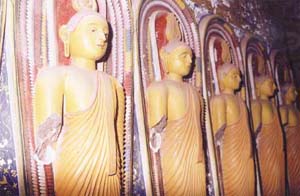 |
 21st June 1998 |
Front Page| |
 Let's do it the Kandalama way |
Contents
|
|
 |
Hands off!Treasure hunters easily led by tales of hidden treasures, think nothing of desecrating sacred artefacts. Despite counter-measures taken by the authorities the menace continues. Sixteen Buddha statues at Pitadeniya Vihare in the little hamlet of Kitulwela in Divulapitya are the latest victims of these treasure hunters. Shelani de Silva reports Sixteen Buddha statues at Pitadeniya Vihare in the little hamlet of Kitulwela in Divulapitya were ravaged by a group of treasure hunters last week. The attack has shocked and angered the villagers who regard the statues as a sacred and integral part of their community.
The 90-year-old statues are kept around the main statue in the shrine room. Of sixteen statues, the right hand of each and six ears had been broken and the heads of two destroyed. All this for the greed of treasure believed to be hidden within. Divulapitiya Police though carrying out investigations had no leads early last week. OIC P. A. S. de Silva, said the Police have found no trace of the culprits. 'The chief priest is unable to give us any names of suspects. The villagers and the patrons of the temple have a very good rapport with the priest so it is very difficult to make any arrest. However we are still investigating," he said.
Podi Hamuduruwo Gasbay Panyasinha who discovered the damage said that as a routine he opens the shrine door room around 6.15 a.m. "On Sunday morning I found some grains of sand near the shrine room. At first I thought I had forgotten to lock the door the previous night. But when I entered I saw the damage. I summoned a neighbour and we went inside," explained the monk. Such acts of vandalism in search of treasure is not new. The problem has grown to such proportions that a special committee was appointed by the Department of Archaeology in February to crack down on treasure hunters. The committee involved Divisional Secretaries, Grama Sevakas, Provincial Archaeology Department officials, Police, chief priests and village committee representatives. Altogether 258 committees were appointed. Jungle shrines, pillars and other artefacts found close to places of archaeological interest and temples have been the targets of these treasure hunters in recent times. Archaeology Department Director Dr. S U Deraniyagala, says there is a mistaken belief that treasures are hidden in ancient statues. "The main cause for this vandalism is the false belief among people and the myth that treasures or valuables were placed in statues and other artifacts. Unfortunately as a result the country is losing its heritage," he said. Laws have been recently passed to deter the treasure hunters. Any person found guilty of causing damage will be liable to a fine not exceeding Rs. 50, 000 or to imprisonment of either not less than two years and not more than five years or to both and such fine and imprisonment. " Such incidents, we believe occur in waves. Sometimes it subsides and again increases. It has become a very big problem, which has escalated in the past few months. We have to educate the people," Dr. Deraniyagala said. Director, Exploration and Documentation at the Archaeology Department Senerath Dissanayake said now that the law has been amended they are able to take stern action, against offenders. 'We have also decided to carry out several programmes. First we will give out leaflets especially to villagers informing them of the penalty and the consequences of such acts and also educate them that there are no treasures in these artefacts. There will also be posters put up in villages. We will also get involved with the media both print and electronic to educate the public.' Mr. Dissanayake says the most affected area is the North Western province where monuments dating to the 9th century AD have been destroyed, Even those done in the Kandyan period have not been spared. 'The damage done to the Devanagala Vihare statues which belong to the Kandyan period and the carvings found at Ridi Vihare are among the recent acts of vandalism. There are also many incidents that go unrecorded,' he said. According to Department records from the period of April 1997 the most affected areas are North Central, North Western and Uva provinces. The department also faces a tough task in attempting to restore damaged artefacts. Lack of funds and skilled hands are major constraints. Thus, much rests with public awareness to heed of the gravity of the problem and be vigilant in preventing such dastardly acts.
More Plus * Those peaks of grandeur
Front Page| News/Comment| Editorial/Opinion| Business| Sports | Mirror Magazine |
|
 |
Please send your comments and suggestions on this web site to |
|
 The
incident occurred on Saturday night after the two priests of the temple
had conducted pirith poojas for the devotees. The Podi Hamuduruwo had completed
his routine of cleaning and locking up of the shrine room around 10.00pm.
He discovered the damage early next morning when he found the iron lock
had been broken and the main shrine room door damaged.
The
incident occurred on Saturday night after the two priests of the temple
had conducted pirith poojas for the devotees. The Podi Hamuduruwo had completed
his routine of cleaning and locking up of the shrine room around 10.00pm.
He discovered the damage early next morning when he found the iron lock
had been broken and the main shrine room door damaged.  Chief
Priest Madithiyawala Panyaseella said this is the first time such an incident
had taken place in the Divulapitya area. "What I cannot understand
is how a person can damage a statue of Lord Buddha. These statues have
no treasures in them, they are made of clay," he said.
Chief
Priest Madithiyawala Panyaseella said this is the first time such an incident
had taken place in the Divulapitya area. "What I cannot understand
is how a person can damage a statue of Lord Buddha. These statues have
no treasures in them, they are made of clay," he said.